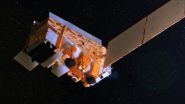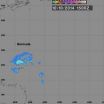UTMB researchers uncover powerful new class of weapons in the war on cancer
2014-10-22
(Press-News.org) An interdisciplinary team of researchers from the University of Texas Medical Branch, and Winship Cancer Institute of Emory University have identified small molecules that can represent a new class of anticancer drugs with a novel target for the treatment of lung cancer. These findings are detailed in Nature Communications. A PCT patent (WO 2013028543 A1) was jointly documented by these two Institutes for the invention.
Survival outcomes remain poor for lung cancer patients in large part because of lung cancer's resistance to conventional therapies. Programmed cell death, or apoptosis, is a natural process within cells that scientists are learning to successfully exploit in cancer therapies. The Bax molecule is required for the decision-making stage for programmed cell death. This research team has previously identified the serine184 site of the Bax molecule as a critical functional switch in controlling its cell death activities. Therefore, the researchers sought to learn how manipulate the Bax molecule at S184 to devise a new strategy for cancer treatment.
In the present study, researchers used the structural pocket around S184 as a docking site to screen about 300,000 small 'drug-like' compounds from the National Cancer Institute's library of small molecules to discover compounds that activate Bax and trigger apoptosis in lung cancer cells. They identified three small-molecule Bax activators that target the S184 site of Bax, activate the cell death machineries of Bax and potently repress lung tumor growth. The researchers also found that application of these compounds to Bax-positive lung cancer tumors did not have any toxic effects on nearby noncancerous tissues.
"These compounds hold potential as an entirely new class of anticancer drugs with a unique therapeutic target for the treatment of cancers expressing Bax, including lung cancer," said Dr. Jia Zhou, lead UTMB author and associate professor at Department of Pharmacology and Center for Addiction Research. "They induce high levels of cell death in lung cancer cells without triggering cell death in noncancerous cells."
INFORMATION:
Other members of the research team include Chunyong Ding and Mark A. White from UTMB; Meiguo Xin and Patrick Corsino from the University of Florida; Xingming Deng, Rui Li, Maohua Xie, Dongkyoo Park, Taofeek Owonikoko, Gabriel Sica, Suresh Ramalingam, Walter Curran and Fadlo Khuri from Emory University and Andrew Magis from the Institute for Systems Biology.
The National Institutes of Health, the Winship Cancer Institute of Emory University and the Flight Attendant Medical Research Institute supported this research.
ELSE PRESS RELEASES FROM THIS DATE:
2014-10-22
While space debris was the uncontrolled adversary in the award-winning space thriller film "Gravity," space debris, also known as "space junk," is an ongoing real-life concern for teams managing satellites orbiting Earth, including NOAA-NASA's Suomi National Polar-orbiting Partnership, or Suomi NPP, satellite. It is not unusual for satellites that have the capability of maneuvering to be repositioned to avoid debris or to maintain the proper orbit.
On an otherwise quiet Sunday on September 28, the Suomi NPP mission team was monitoring a possible close approach of a debris ...
2014-10-22
Many cancer patients use dietary supplements such as vitamins, minerals and herbs or other botanicals but often don't tell their doctor.
This gap in communication can happen when patients believe that their doctors are indifferent or negative toward their use of these supplements. As a result, patients may find information about dietary supplements from unreliable sources, exposing themselves to unneeded risks. Since information on these dietary supplements is limited, researchers from the University of Texas Medical Branch describe a practical patient-centered approach ...
2014-10-22
AMES, Iowa – News of a school shooting or a homicide involving a teenage suspect always leads to the question of why? It is human nature to want an explanation or someone to blame, and policymakers try to pinpoint a cause in an effort to prevent it from happening again. But too often, the speculation or rush to judgment clouds reality, said Matt DeLisi, a professor of sociology and criminal justice at Iowa State University.
"Anytime you have violence, such as a school shooting, people gravitate to single-item explanations that cite mental illness, guns, bullying ...
2014-10-22
CHICAGO --- A nano-sized discovery by Northwestern Medicine® scientists helps explain how bipolar disorder affects the brain and could one day lead to new drug therapies to treat the mental illness.
Scientists used a new super-resolution imaging method -- the same method recognized with the 2014 Nobel Prize in chemistry -- to peer deep into brain tissue from mice with bipolar-like behaviors. In the synapses (where communication between brain cells occurs), they discovered tiny "nanodomain" structures with concentrated levels of ANK3 -- the gene most strongly associated ...
2014-10-22
VIDEO:
This rainfall analysis showed that Gonzalo generated several areas over the Atlantic Ocean where rainfall totals topped 12 inches (red). Fay's maximum rainfall appeared between 4 and 8 inches (green)....
Click here for more information.
The Tropical Rainfall Measuring Mission or TRMM satellite can estimate rainfall rates from its orbit in space and that data is used to create a rainfall analysis and calculate total rainfall for weather events in the tropics. NASA used ...
2014-10-22
Tropical Storm Ana was being battered by wind shear when NASA's Terra satellite passed overhead and saw the bulk of showers and thunderstorms pushed north and east of the center.
NASA's Terra satellite flew over Tropical Storm Ana as it was moving past Hawaii on Oct. 21 at 21:30 UTC (5:30 p.m. EDT) and the Moderate Resolution Imaging Spectroradiometer (MODIS) instrument took a visible picture of the storm. The MODIS image showed that the strong southwesterly wind shear that was affecting the storm on Oct. 20 continued through Oct. 21 as the bulk of clouds and showers ...
2014-10-22
WORCESTER, MA –Using an innovative exome sequencing strategy, a team of international scientists led by John Landers, PhD, at the University of Massachusetts Medical School has shown that TUBA4A, the gene encoding the Tubulin Alpha 4A protein, is associated with familial amyotrophic lateral sclerosis (ALS), a fatal neurological disorder also known as Lou Gehrig's Disease. Details of the study were published today in Neuron.
Exome sequencing, in contrast to whole genome sequencing, relies on sequencing only the protein-coding genes in a genome and has been an effective ...
2014-10-22
The Bureau of Reclamation has released a report summarizing six years of testing coatings to control the attachment of quagga and zebra mussels to water and power facilities. Since the study began in 2008, Reclamation has tested more than 100 coatings and materials.
"Controlling attachment of invasive quagga and zebra mussels on Bureau of Reclamation facilities is important to ensure water delivery and hydropower generation," principal researcher Allen Skaja said. "Though we have tested many different coatings, three durable foul-release coatings are showing promise ...
2014-10-22
Worcester, Mass. – People paralyzed by spinal cord injuries lose mechanical strength in their leg bones faster, and more significantly, than previously believed, putting them at greater risk for fractures from minor stresses, according to a new study by a research team at Worcester Polytechnic Institute (WPI).
The results suggest that physicians need to begin therapies for spinal cord injury patients sooner to maintain bone mass and strength. The data also serve as warning to physicians treating patients with osteoporosis to think beyond the standard bone density ...
2014-10-22
Combining a PET scanner with a new chemical tracer that selectively tags specific types of bacteria, Johns Hopkins researchers working with mice report they have devised a way to detect and monitor in real time infections with dangerous Gram-negative bacteria. These increasingly drug-resistant bacteria are responsible for a range of diseases, including fatal pneumonias and various bloodstream or solid-organ infections acquired in and outside the hospital.
"What we have produced is essentially a system that localizes the epicenter of infection and provides real-time tracking ...
LAST 30 PRESS RELEASES:
[Press-News.org] UTMB researchers uncover powerful new class of weapons in the war on cancer




